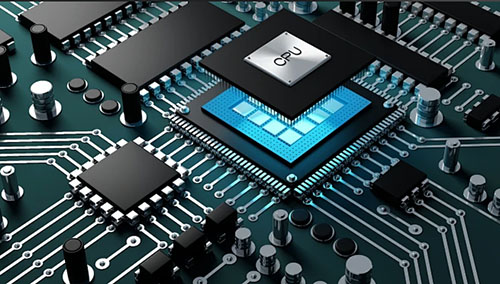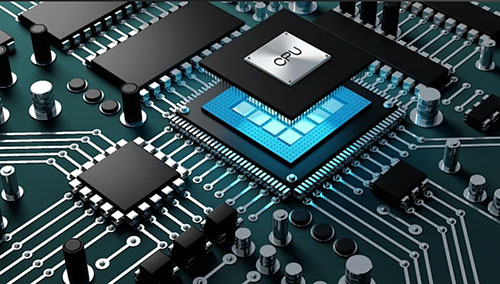
Product: AI Server PCB
Material: High-Tg FR4, PTFE, CCL
Layer Count: 20-28 layers
Copper Thickness: 1.0 oz
Finished PCB Thickness: 4mm
Solder Mask Colour: Green, Red, Blue, Black
Surface Finish: ENIG, HASL, No-Electroless Gold, Immersion Silver
Application Areas: Motherboards, Computing Units, Power Management, High-Speed Interfaces and Storage Control
AI server PCBs are high-performance printed circuit boards specifically engineered for artificial intelligence servers. Functioning as the “nerve centre” connecting GPUs, CPUs, memory, and high-speed interconnects, their technological sophistication and material properties directly determine the server's computational power ceiling and data transmission efficiency.
During the early stages of AI computing, traditional PCBs played a pivotal role. PCBs serve as the structural foundation for electronic components, often termed the ‘motherboard of electronics,’ facilitating relay transmission. AI server PCBs typically integrate hardware such as CPUs, memory, hard drives, power supplies, and network cards.
However, as AI servers demand ever-increasing computational power, traditional PCBs face significant challenges. Compared to conventional servers, AI servers exhibit characteristics including high transmission rates, high memory bandwidth, and complex hardware architectures.
This necessitates three key innovations in PCB design:
● Increased area: Beyond the motherboard housing the CPU, each GPU in AI servers must be individually encapsulated within a GPU module board and integrated onto a single motherboard. Compared to traditional servers utilising just one motherboard, this significantly increases PCB footprint.
● Increased layer count: To accommodate more complex routing, additional PCB layers are required to enhance performance aspects such as impedance control.
● Material upgrades: AI server PCBs demand higher transmission speeds, superior thermal management, and reduced losses. Their core material, Copper Clad Laminate (CCL), must exhibit high-speed, high-frequency, and low-loss characteristics.
The supply dynamics for AI server PCBs are also relatively complex. GPU board assemblies are typically designed entirely by GPU manufacturers, who consequently control the PCB supply chain decisions. CPU board assemblies follow established server manufacturer supply chain relationships: CPU carrier boards are determined by CPU designers, while CPU templates and expansion card boards for complete systems are specified by end customers. Other PCB boards containing chips are usually procured by functional component manufacturers after receiving design requirements from customers, with these suppliers independently deciding PCB sourcing. Accessories are generally procured directly by customers from established module manufacturers' mature products. In certain scenarios, customers may submit specific design requirements to accessory module suppliers; however, this does not affect the module manufacturers' autonomy in PCB procurement decisions.
AI server PCBscan be categorised into multilayer PCBs, high-density interconnect (HDI) boards, and other types. Multilayer PCBs achieve superior signal integrity and power distribution capabilities by stacking multiple conductive and insulating layers, forming the core foundation for AI servers processing large-scale data computations.
HDI boards employ advanced techniques such as micro blind vias and buried vias, offering higher routing density and slim profiles to meet the high-speed, high-frequency transmission demands of AI chips;
Other PCB types, including rigid-flex boards and specialised material boards, primarily address specific thermal management, reliability, or structural design requirements, collectively underpinning AI servers' high performance and reliability.
Core Functions of AI Server PCBs:
Electrical Connectivity and Signal Transmission
Precise copper foil interconnections link core components such as GPUs, CPUs, and memory, enabling high-speed data exchange. For instance, in NVIDIA's GB200 architecture, HDI (High-Density Interconnect) boards support 1800Gb/s interconnect bandwidth, meeting the massive data transfer demands between AI chips.
Impedance control technology (±5% tolerance) minimises high-speed signal interference, ensuring data integrity.
Mechanical Support and Thermal Management
Provides physical fixation for components. For instance, FR-4 substrates offer bending strength up to 400 MPa, ensuring structural stability.
Certain designs incorporate metal substrates (e.g., aluminium substrates with thermal conductivity 2.0 W/mK) to assist heat dissipation from high-power devices.
High-Density Integration and Miniaturisation
Mobile phone motherboards accommodate over 5,000 solder joints within 10cm², while AI server PCBs achieve higher-density routing through multilayer stacking (e.g., 40+ layers) to support complex circuit integration.

AI Server PCB Design Requirements:
Multilayer Design: Server PCBs typically require multilayer construction to provide additional power planes, ground planes, and signal layers. This enhances signal integrity and immunity to interference while better managing isolation between analogue and digital signals.
High-Density Layout: Server PCBs must accommodate extensive electronic components and interconnections. Consequently, high-density layout is essential to ensure adequate component spacing and connection stability. Simultaneously, it reduces board footprint and improves system integration.
Power management: Servers frequently require support for multiple voltages and power sources, including normal operating voltage, standby power, and battery backup. Consequently, server PCB design must incorporate power management functions such as voltage regulation circuits, filters, and power switches.
Thermal Design: AI Server PCBs must address heat dissipation, particularly around power supply sections and high-power components. PCB design should incorporate heat sink placement, thermal path routing, and ventilation hole configuration to ensure reliable operation and effective temperature regulation.
Signal Integrity: Servers demand exceptional signal integrity due to high-speed data transmission and complex signal processing. PCB design must address signal transmission line impedance matching, minimise signal reflections and crosstalk to enhance signal quality and system performance.
Reliability and Durability: Servers typically operate continuously under demanding environmental conditions. PCB design must therefore prioritise reliability and durability through high-quality materials, optimal layout, and enhanced resistance to voltage surges and vibration.
The evolution of AI server PCBs represents a dual outcome of technological demands and industrial synergy. Confronted with AI computing's stringent requirements for data transmission rates, integration density, and reliability, PCBs have achieved performance leaps through increased layer counts, material upgrades, and process innovations. Concurrently, the supply chain's division of labour has become increasingly specialised due to GPU-dominated design systems.
Product: AI Server PCB
Material: High-Tg FR4, PTFE, CCL
Layer Count: 20-28 layers
Copper Thickness: 1.0 oz
Finished PCB Thickness: 4mm
Solder Mask Colour: Green, Red, Blue, Black
Surface Finish: ENIG, HASL, No-Electroless Gold, Immersion Silver
Application Areas: Motherboards, Computing Units, Power Management, High-Speed Interfaces and Storage Control
iPCB Circuit provides support for PCB design, PCB technology, and PCBA assembly. You can request technical consultation or quotation for PCB and PCBA here, please contact email: sales@ipcb.com
We will respond very quickly.